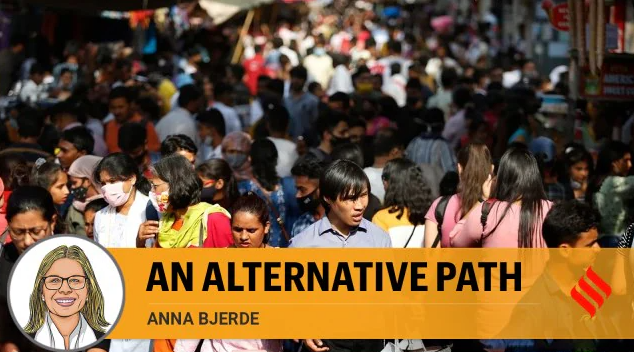An Alternative Path (GS Paper 3, Indian Economy)

Introduction
- India emerged as the bright spot amid a weak global outlook. With a 7.5 percent growth estimate, India is one of the fastest growing significant economy.
- India’s growth story provides a development model to be followed by many developing countries.
Analysis of India’s growth path
- India’s development path is demonstrating the impacts of public and private sector initiative, innovation, and resilience that could be replicated in other countries.
- As we seek to learn what works and scale it up, India offers practical development knowledge at the federal, state, and local levels.
- We see India as a development sandbox for testing real-world solutions that can be tailored and scaled through South-South knowledge exchange.
- It can be demonstrated by emphasizing three examples: The energy transition, digital public infrastructure, and female empowerment.
Energy Transition
- There is still a long way to go, but India has made important progress on the energy transition, with renewable energy making up 42 per cent of its total power generation capacity.
- India is currently the world’s fourth largest renewables market and home to 3 per cent of the global solar manufacturing capabilities.
- Over the past five years, India has invested close to $10 billion every year into renewables and ranks among the world’s five emerging and middle-income economies with large scale public investment in renewable energy.
- The country has also supported the adoption of EVs and the production of green hydrogen.
- Investors thus rightly see India’s clean energy shift as a big opportunity.
- And the World Bank has been able to contribute with investments of about $1 billion in solar parks and rooftop solar in the country having leveraged 40 times that amount in commercial investment.
- India is now poised for the next phase of its energy transition which will require addressing the intermittency of renewable energy sources through investments in transmission and storage, promoting the large-scale and rapid electrification of transportation, and catalysing investments in technologies that will foster industrial decarbonisation.
Digital public infrastructure (DPI)
- With its digital public infrastructure (DPI) initiative, India has pioneered the use of technology for inclusion.
- With a digitally verifiable proof of identity, millions of people can now access social safety net payments, open bank accounts, and receive government services without the need to stand in queues, negotiate with public officials, and fill out paper forms.
- The use of digital payments has also reduced delays in the payment of maternal health conditional cash transfers by 43 per cent.
- In many states, micro-entrepreneurs are working in a cashless environment and using digital networks to serve a wider market, access finance, and expand their businesses.
- While affordable connectivity remains a key constraint, digital innovation is transforming entire rural communities from online health consultations and remote learning to e-commerce and fin-tech.
- India offers valuable lessons on how countries can make use of the digital economy for growth, inclusion, and poverty reduction and the World Bank is sharing the lessons of India’s DPI journey with other countries.
Female empowerment
- Although India’s female labour force participation is behind other countries, an encouraging sign is that this could be changing.
- India is providing many policy support to women like working women hostels, cheap credits, handholding support.
- Combined with improved access to finance, such initiatives have helped boost the female labour force in industry to 43 per cent of the national total.
- The National Rural Livelihoods Mission, supported by the World Bank, has empowered millions of rural women by organising them into self-help groups.
- More than $4 billion in commercial credit has been mobilised to support women-led cooperatives and rural enterprises.
- If India can take these experiences to scale, it could raise its female labour force participation to the developing country average of 50 per cent — adding a full percentage point to the country’s potential growth rate and lifting up a generation of Indian women and girls.
Conclusion
- Investment in energy transition, digital public infrastructure, and female empowerment is taking the country towards a green and sustainable future.
- With the world’s largest population and an aspiration to reach high-income county status by 2047, India will continue to write important chapters in the book on global development.


